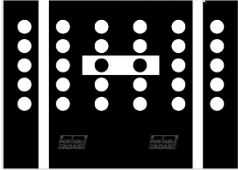Aligning Your View: The Essential Guide to Windshield Camera Calibration
In today's automotive landscape, advanced driver-assistance systems (ADAS) are becoming increasingly common in vehicles. These systems rely heavily on cameras and sensors that are often mounted on or near the windshield. Proper calibration of these components is essential to ensure that these safety features function as intended, providing drivers with reliable support on the road. However, the calibration process can seem daunting, especially for those without extensive experience in automotive technology.
This guide aims to demystify the process of windshield camera calibration, discussing the importance of aligning your vehicle's view for optimal performance. We'll explore various tools and systems available on the market, including portable ADAS solutions and affordable calibration stands that are under $5500. By understanding your options, including products like the Carcal ADAS and the Subaru mono calibration target, you can make informed decisions to help maintain and enhance the safety features of your vehicle. Whether you're a professional technician or a car enthusiast, this guide will equip you with the knowledge needed for effective auto glass camera calibration.
Understanding ADAS and Its Importance
Advanced Driver Assistance Systems, or ADAS, are technologies designed to enhance vehicle safety and facilitate driving. These systems use a combination of sensors, cameras, and artificial intelligence to assist drivers in various tasks, such as lane keeping, adaptive cruise control, and collision avoidance. As vehicles become increasingly equipped with these technologies, calibrating the associated cameras and sensors becomes essential for proper functionality.
Calibration ensures that the cameras and sensors are aligned precisely with the vehicle's intended use and driving conditions. When a windshield is replaced or when components are adjusted, the camera's perspective may shift, potentially leading to misalignment. This can compromise the effectiveness of the ADAS features, resulting in safety risks. Therefore, proper calibration is vital to maintain the accuracy and reliability of these advanced safety functions.
With the increasing adoption of ADAS across various vehicle models, understanding the calibration process is crucial for automotive professionals and vehicle owners alike. Investing in portable ADAS systems can simplify the calibration process, making it accessible even for smaller shops. By prioritizing calibration, vehicle owners can ensure that their ADAS systems operate at full capacity, enhancing both safety and overall driving experience.
Choosing the Right ADAS Calibration System
When selecting an ADAS calibration system, it is crucial to consider your specific needs and budget. With a variety of options available, you can find systems that cater to professional automotive technicians as well as DIY enthusiasts. Affordable choices, like the Carcal ADAS, offer reliable performance without breaking the bank, making them suitable for smaller shops or individual users looking for quality calibration solutions under five thousand five hundred dollars.

Another key factor is the portability of the ADAS calibration system. A portable ADAS stand allows for convenience and ease of use, especially when working in various locations or when space is limited in your shop. Systems designed for portability, such as the Affordable Auto Glass ADAS Target System, provide flexibility while ensuring accurate calibration. This is essential for maintaining the safety features of modern vehicles that rely heavily on advanced driver-assistance systems.
Additionally, consider the types of calibration required for the vehicles you work on. Different vehicles might necessitate specific targets or setups, such as the Subaru mono calibration target for Subaru models. Moreover, investing in a static ADAS calibration stand can enhance precision and reliability, ensuring that the calibration process meets industry standards. Exploring options like a static ADAS calibration stand under five thousand five hundred will help you strike the right balance between affordability and functionality in your selection process.
Best Practices for Windshield Camera Calibration
To ensure accurate windshield camera calibration, it is essential to start with a clean and unobstructed windshield. Make sure the area around the windshield is free from dirt, debris, and any obstructions that could affect the calibration process. Additionally, inspect the camera for any damages or misalignments before proceeding. This initial step is crucial, as even the smallest imperfection can lead to inaccuracies in the calibration results.
Using quality calibration equipment is another best practice to follow. For those utilizing a Portable ADAS, consider options like the Carcal ADAS and other affordable ADAS calibration stands under $5500. These systems are designed to deliver reliable results without breaking the bank. When selecting an ADAS system, ensure it is compatible with the specific vehicle make and model, as this will improve the calibration’s effectiveness and accuracy.
Lastly, adhere to the manufacturer's guidelines and specifications when performing the calibration. Each vehicle and ADAS system has unique requirements, and following these instructions carefully can prevent future malfunctions. Using specialized auto glass camera calibration targets, like Subaru mono calibration target s, can further enhance the precision of your calibration. By implementing these best practices, you can achieve optimal performance from your ADAS and enhance the safety of your vehicle.